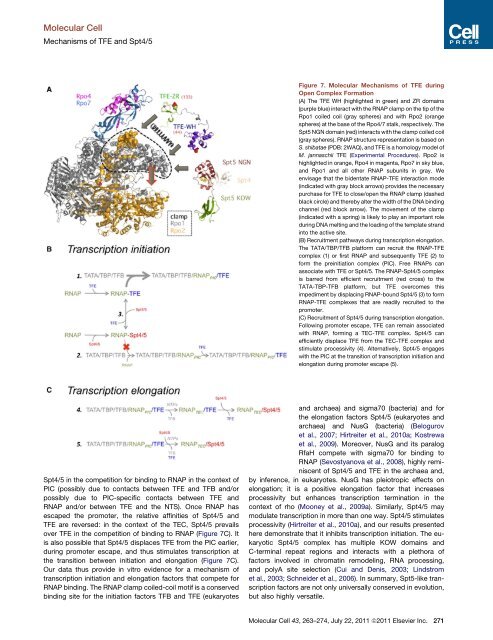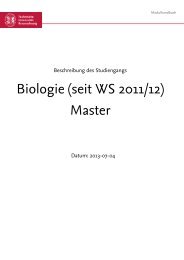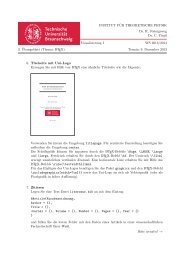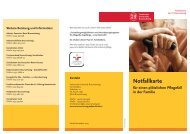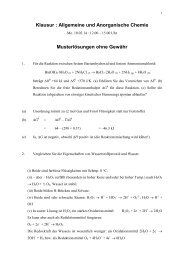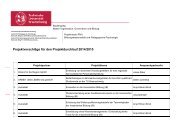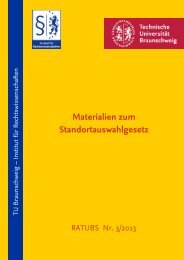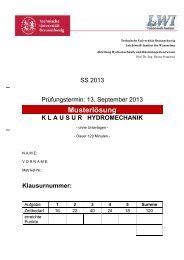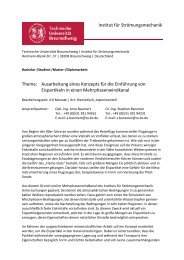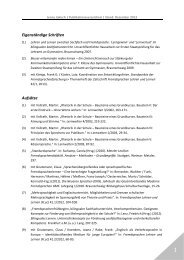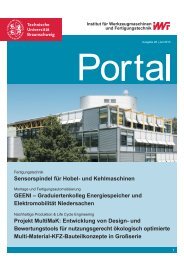L - Technische Universität Braunschweig
L - Technische Universität Braunschweig
L - Technische Universität Braunschweig
Create successful ePaper yourself
Turn your PDF publications into a flip-book with our unique Google optimized e-Paper software.
Molecular Cell<br />
Mechanisms of TFE and Spt4/5<br />
Figure 7. Molecular Mechanisms of TFE during<br />
Open Complex Formation<br />
(A) The TFE WH (highlighted in green) and ZR domains<br />
(purple blue) interact with the RNAP clamp on the tip of the<br />
Rpo1 coiled coil (gray spheres) and with Rpo2 (orange<br />
spheres) at the base of the Rpo4/7 stalk, respectively. The<br />
Spt5 NGN domain (red) interacts with the clamp coiled coil<br />
(gray spheres). RNAP structure representation is based on<br />
S. shibatae (PDB: 2WAQ), and TFE is a homology model of<br />
M. jannaschii TFE (Experimental Procedures). Rpo2 is<br />
highlighted in orange, Rpo4 in magenta, Rpo7 in sky blue,<br />
and Rpo1 and all other RNAP subunits in gray. We<br />
envisage that the bidentate RNAP-TFE interaction mode<br />
(indicated with gray block arrows) provides the necessary<br />
purchase for TFE to close/open the RNAP clamp (dashed<br />
black circle) and thereby alter the width of the DNA binding<br />
channel (red block arrow). The movement of the clamp<br />
(indicated with a spring) is likely to play an important role<br />
during DNA melting and the loading of the template strand<br />
into the active site.<br />
(B) Recruitment pathways during transcription elongation.<br />
The TATA/TBP/TFB platform can recruit the RNAP-TFE<br />
complex (1) or first RNAP and subsequently TFE (2) to<br />
form the preinitiation complex (PIC). Free RNAPs can<br />
associate with TFE or Spt4/5. The RNAP-Spt4/5 complex<br />
is barred from efficient recruitment (red cross) to the<br />
TATA-TBP-TFB platform, but TFE overcomes this<br />
impediment by displacing RNAP-bound Spt4/5 (3) to form<br />
RNAP-TFE complexes that are readily recruited to the<br />
promoter.<br />
(C) Recruitment of Spt4/5 during transcription elongation.<br />
Following promoter escape, TFE can remain associated<br />
with RNAP, forming a TEC-TFE complex. Spt4/5 can<br />
efficiently displace TFE from the TEC-TFE complex and<br />
stimulate processivity (4). Alternatively, Spt4/5 engages<br />
with the PIC at the transition of transcription initiation and<br />
elongation during promoter escape (5).<br />
Spt4/5 in the competition for binding to RNAP in the context of<br />
PIC (possibly due to contacts between TFE and TFB and/or<br />
possibly due to PIC-specific contacts between TFE and<br />
RNAP and/or between TFE and the NTS). Once RNAP has<br />
escaped the promoter, the relative affinities of Spt4/5 and<br />
TFE are reversed: in the context of the TEC, Spt4/5 prevails<br />
over TFE in the competition of binding to RNAP (Figure 7C). It<br />
is also possible that Spt4/5 displaces TFE from the PIC earlier,<br />
during promoter escape, and thus stimulates transcription at<br />
the transition between initiation and elongation (Figure 7C).<br />
Our data thus provide in vitro evidence for a mechanism of<br />
transcription initiation and elongation factors that compete for<br />
RNAP binding. The RNAP clamp coiled-coil motif is a conserved<br />
binding site for the initiation factors TFB and TFE (eukaryotes<br />
and archaea) and sigma70 (bacteria) and for<br />
the elongation factors Spt4/5 (eukaryotes and<br />
archaea) and NusG (bacteria) (Belogurov<br />
et al., 2007; Hirtreiter et al., 2010a; Kostrewa<br />
et al., 2009). Moreover, NusG and its paralog<br />
RfaH compete with sigma70 for binding to<br />
RNAP (Sevostyanova et al., 2008), highly reminiscent<br />
of Spt4/5 and TFE in the archaea and,<br />
by inference, in eukaryotes. NusG has pleiotropic effects on<br />
elongation; it is a positive elongation factor that increases<br />
processivity but enhances transcription termination in the<br />
context of rho (Mooney et al., 2009a). Similarly, Spt4/5 may<br />
modulate transcription in more than one way. Spt4/5 stimulates<br />
processivity (Hirtreiter et al., 2010a), and our results presented<br />
here demonstrate that it inhibits transcription initiation. The eukaryotic<br />
Spt4/5 complex has multiple KOW domains and<br />
C-terminal repeat regions and interacts with a plethora of<br />
factors involved in chromatin remodeling, RNA processing,<br />
and polyA site selection (Cui and Denis, 2003; Lindstrom<br />
et al., 2003; Schneider et al., 2006). In summary, Spt5-like transcription<br />
factors are not only universally conserved in evolution,<br />
but also highly versatile.<br />
Molecular Cell 43, 263–274, July 22, 2011 ª2011 Elsevier Inc. 271


